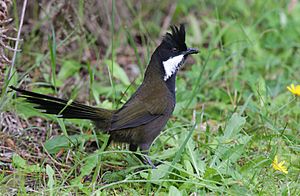Psophodidae facts for kids
Quick facts for kids Psophodidae |
|
|---|---|
 |
|
| Eastern whipbird (Psophodes olivaceus) | |
| Scientific classification |
|
| Kingdom: | Animalia |
| Phylum: | Chordata |
| Class: | Aves |
| Order: | Passeriformes |
| Suborder: | Passeri |
| Family: | Psophodidae Bonaparte, 1854 |
| Genera | |
|
See list below |
|
Psophodidae is a family of small passerine birds that live in Australia and nearby areas. These birds are often called whipbirds and wedgebills. Scientists sometimes group other birds, like quail-thrushes and jewel-babblers, with them. This family has a bit of a confusing history because different scientists have different ideas about which birds belong together.
Contents
Understanding Bird Families
Scientists group animals into families based on how closely they are related. For the Psophodidae family, it's been tricky to decide which birds fit best.
Whipbirds and Wedgebills
In the simplest way, the Psophodidae family includes only the 5 or 6 species of whipbirds and wedgebills. These birds are found in Australia.
Other Related Birds
Some scientists also include:
- Quail-thrushes: There are about 8 species of these ground-dwelling birds. They live in Australia and New Guinea.
- Jewel-babblers: These are 3 or 4 species found in the rainforests of New Guinea.
Other scientists think the quail-thrushes and jewel-babblers should be in their own family called Cinclosomatidae. The names of bird families can change depending on new discoveries about how birds are related.
Bird Characteristics
Whipbirds and wedgebills are medium-sized birds, usually between 19 and 31 centimeters (about 7 to 12 inches) long. They are mostly olive-green or brown and often have a small crest on their heads.
Where These Birds Live
Whipbirds and wedgebills are all found in Australia. They live in many different places, from wet rainforests to dry, scrubby areas.
The western whipbird is considered "near-threatened." This means its numbers are getting low, mainly because its home is being destroyed and due to fires. The Papuan whipbird is listed as "data deficient," which means scientists don't have enough information to know if it's in danger or not.
How They Behave
These birds spend most of their time on the ground. They don't fly very well and prefer to hide or run away when they feel threatened.
What They Eat
Whipbirds and wedgebills look for food on the ground. They mostly eat insects and other small creatures without backbones, like worms or spiders. In desert areas, quail-thrushes also eat some seeds.
Nesting and Eggs
These birds build a cup-shaped nest among shrubs or right on the ground. Female birds usually lay two or three eggs in their nests.
Species List
- Genus Androphobus
- Papuan whipbird, Androphobus viridis
- Genus Psophodes
- Eastern whipbird, Psophodes olivaceus
- Black-throated whipbird, Psophodes nigrogularis
- White-bellied whipbird, Psophodes leucogaster
- Chiming wedgebill, Psophodes occidentalis
- Chirruping wedgebill, Psophodes cristatus
See also
 In Spanish: Psophodidae para niños
In Spanish: Psophodidae para niños



